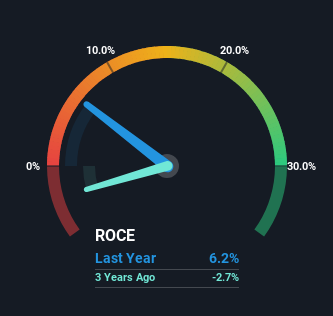Stock Analysis
- Brazil
- /
- Specialty Stores
- /
- BOVESPA:CEAB3
C&A Modas (BVMF:CEAB3) Is Reinvesting At Lower Rates Of Return

What are the early trends we should look for to identify a stock that could multiply in value over the long term? One common approach is to try and find a company with returns on capital employed (ROCE) that are increasing, in conjunction with a growing amount of capital employed. Ultimately, this demonstrates that it's a business that is reinvesting profits at increasing rates of return. Although, when we looked at C&A Modas (BVMF:CEAB3), it didn't seem to tick all of these boxes.
What Is Return On Capital Employed (ROCE)?
Just to clarify if you're unsure, ROCE is a metric for evaluating how much pre-tax income (in percentage terms) a company earns on the capital invested in its business. Analysts use this formula to calculate it for C&A Modas:
Return on Capital Employed = Earnings Before Interest and Tax (EBIT) ÷ (Total Assets - Current Liabilities)
0.062 = R$389m ÷ (R$9.4b - R$3.2b) (Based on the trailing twelve months to December 2023).
Thus, C&A Modas has an ROCE of 6.2%. Ultimately, that's a low return and it under-performs the Specialty Retail industry average of 8.5%.
Check out our latest analysis for C&A Modas

In the above chart we have measured C&A Modas' prior ROCE against its prior performance, but the future is arguably more important. If you'd like, you can check out the forecasts from the analysts covering C&A Modas for free.
What Does the ROCE Trend For C&A Modas Tell Us?
When we looked at the ROCE trend at C&A Modas, we didn't gain much confidence. Over the last five years, returns on capital have decreased to 6.2% from 21% five years ago. Meanwhile, the business is utilizing more capital but this hasn't moved the needle much in terms of sales in the past 12 months, so this could reflect longer term investments. It may take some time before the company starts to see any change in earnings from these investments.
On a related note, C&A Modas has decreased its current liabilities to 34% of total assets. That could partly explain why the ROCE has dropped. What's more, this can reduce some aspects of risk to the business because now the company's suppliers or short-term creditors are funding less of its operations. Some would claim this reduces the business' efficiency at generating ROCE since it is now funding more of the operations with its own money.
Our Take On C&A Modas' ROCE
In summary, C&A Modas is reinvesting funds back into the business for growth but unfortunately it looks like sales haven't increased much just yet. And investors may be recognizing these trends since the stock has only returned a total of 2.0% to shareholders over the last three years. As a result, if you're hunting for a multi-bagger, we think you'd have more luck elsewhere.
Like most companies, C&A Modas does come with some risks, and we've found 2 warning signs that you should be aware of.
If you want to search for solid companies with great earnings, check out this free list of companies with good balance sheets and impressive returns on equity.
Valuation is complex, but we're helping make it simple.
Find out whether C&A Modas is potentially over or undervalued by checking out our comprehensive analysis, which includes fair value estimates, risks and warnings, dividends, insider transactions and financial health.
View the Free AnalysisHave feedback on this article? Concerned about the content? Get in touch with us directly. Alternatively, email editorial-team (at) simplywallst.com.
This article by Simply Wall St is general in nature. We provide commentary based on historical data and analyst forecasts only using an unbiased methodology and our articles are not intended to be financial advice. It does not constitute a recommendation to buy or sell any stock, and does not take account of your objectives, or your financial situation. We aim to bring you long-term focused analysis driven by fundamental data. Note that our analysis may not factor in the latest price-sensitive company announcements or qualitative material. Simply Wall St has no position in any stocks mentioned.

Simply Wall St
About BOVESPA:CEAB3
Reasonable growth potential with adequate balance sheet.
